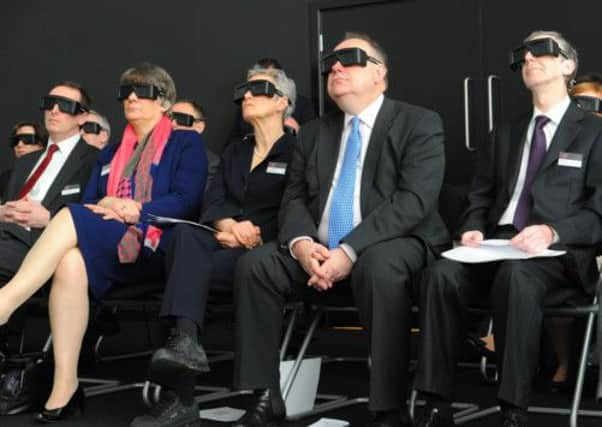Scots scientists: People can see 3D with one eye


They have discovered that, contrary to popular belief, people can experience 3D vision through a single eye - simply by looking through a small hole.
And they believe the discovery could ultimately make it possible for film star Johnny Depp and millions of others who suffers from stereo blindness to see fully in three dimensions for the first time.
Advertisement
Hide AdAdvertisement
Hide AdDepp revealed two years ago when his first movie in 3D was released - “Pirates of the Caribbean: On Stranger Tides” - that he was unable to watch the movie in 3D because he had a “weird eye.” He is thought to suffer from a form of stereoblindness, which means his eyes are not aligned properly, preventing him from seeing fully in three dimensions.
But Dr Dhanraj Vishwanath, a psychologist at St Andrews University, revealed today that it is possible to see in 3D with just one eye by looking at a normal picture through a small circular hole.
And it is claimed his findings, published in the latest issue of Psychological Science, will have implications for people who have just one eye or difficulties with double-eye vision as well as the development of 3D technology. It could open up the possibility of developing other, and possibly cheaper, methods by which the 3D experience can be created.
According to the study, current thinking is that it takes two visual images - one from each eye - to be combined in the visual cortex of the brain to produce our sense of depth that produces the “special” 3D effect. But the St Andrews study suggests that, in fact, both eyes are not necessary for this 3D experience.
Dr Vishwanath explained: “We have demonstrated experimentally, for the first time, that the same ‘special way’ in which depth is experienced in 3D movies can also be experienced by looking at a normal picture with one eye viewing through a small aperture.
“While this effect has been known for a long time, it is usually dismissed. Now we have shown that it is in fact real, and the perceptual results are exactly like stereoscopic 3D, the kind seen in 3D movies. Based on this finding, we have provided a new hypothesis of what the actual cause of the 3D experience might be.”
Dr Vishwanath, said that, since the invention of the stereoscope - the technology behind 3D movies - in 1838, the conventional assumption has been that this added feeling of depth can only occur when the real world or a 3D stereoscopic image is viewed with two eyes.
He continued: “Most people understand what 3D is - for example, when watching a 3D movie with special goggles, objects appear more vividly three-dimensional, they seem real, and they look like you could reach out and touch them. There is also a sense of real space. This is also the way depth, space and 3D objects are experienced when the real world is viewed with two eyes by people who have ‘normal’ binocular vision.”
Advertisement
Hide AdAdvertisement
Hide AdThe St Andrews’ findings suggest that in fact “seeing in 3D” is not something that can only be experienced by people with two fully working eyes. Instead, the researchers say that in principle it is possible for those with only one eye, or have problems with their two-eye vision to experience the “compelling’” effect of 3D.
Dr Vishwanath continued: “Many of these people don’t know what it means ‘to see in 3D’ because they have never experienced it. Our findings and preliminary results suggest that our method could be used to allow people with misaligned eyes (strabismics) to experience what it is like to actually see in 3D.”
He and his colleagues are now testing the method with a large group of people whose eyes are not properly aligned with each other. Nearly 15 per cent of the population, including Johnny Depp, may suffer from some form of misalignment.
Dr Vishwanath said: “This work has significant implications for people who don’t have normal binocular vision: First it could help them experience what it means to see in 3D. Second, it could encourage them to seek therapy to try to regain two-eye 3D vision, which produces the strongest 3D effect in everyday life, once they can see first-hand what ‘seeing in 3D’ is really like. “
He also suggested that, based on his theory, the real 3D experience could be induced simply by increasing the resolution on ultra-high definition television sets. Such methods could also help avoid some of the problems associated with stereoscopic 3D such as fatigue, nausea and headaches.
A university spokesman said: “Later this year, Dr Vishwanath will publish more research outlining the difference between seeing a normal picture in 3D and that experienced in 3D movies.”